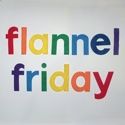From Paula Mason, Milwaukee Public Library:
I created this flannel board as a simple exploration of how even our faces are composed of several shapes, and even by slightly moving those shapes, we can express different emotions. The felt pieces are very easy to make, and you can be as creative as you’d like with them. I included the following to match with some of the shapes we were discussing in storytime that day:Un óvalo - la cara
Un triángulo - la nariz
Dos círculos - los ojos
Un semicírculo - la boca
Dos semicírculos más pequeños - las orejas
Dos rectángulos - las cejas
Un cuadro grande - el cuerpo
Los garabatos (varios pedazos de estambre) - el cabello
Tres rectángulos largos y delgados - las rayas del suéter
Dos círculos más pequeños - las pupilas de los ojos
An oval - the face
A triangle - the nose
Two circles - the eyes
A half-circle - the mouth
Two smaller half-circles - the ears
Two rectangles - the eyebrows
A large square - the body
Squiggles (several pieces of yarn) - the hair
Three long and thin rectangles - the stripes on the sweater
Two smaller circles -
Note: you could also decide to take out some of these pieces depending on the age level of the children, and whether you’d like to extend or shorten the activity.
During the storytime, I mentioned to the children that I wanted to introduce them to a friend, Freddy Figuras, but that we have to first put Freddy together with each shape. I asked the children to help me make the decisions about each shape. Once we have put him together, we also discussed how moving a shape a bit can change his mood, ie. half-circle for mouth turned up=happy, turned down=sad ,and eyebrows turned downward=mad,or upward=curious.
A few of Freddy’s faces—feliz, triste, y enojado (maybe because he lost most of his hair!)
Later, during the play literacy portion of storytime, you could place out all of Freddy’s pieces and let the children make different and unique interpretations of a person or face by using the shapes. You could also place out extra shapes so they have even more pieces to play with.
A very tall Freddy with a big, goofy hat:
As for the books that I paired with this activity, we first read Round is a Tortilla: A Book of Shapes by Roseanne Greenfield Thong, and illustrated by John Parra. We then explored Eric Carle’s bilingual board book: My Very First Book of Shapes/Mi primer libro de figuras. The kids loved both—the rich illustrations in Round is a Tortilla and questions that the author posed, and the fun split pages that make Eric Carle’s book feel like a game. I also did a fingerplay with this activity in which we drew shapes in the air with our fingers. Another idea could be to sing a bilingual version of “When You’re Happy and You know It” after discussing emotions with Freddy’s face. Finally, in discussing the activity with the parents, you could mention the following:
Children can build their narrative skills when being creative, whether they are playing with shapes, drawing, or playing with puppets. By moving the shapes on Freddy’s face, we can begin to craft a story around Freddy and his feelings.
Los niños pueden desarrollar sus habilidades narrativas cuando están usando su creatividad, ya sea que estén jugando con formas, dibujando, o jugando con títeres. Cuando movemos las figuras de la cara de Freddy, podemos empezar a construir una historia acerca de Freddy y sus sentimientos.
¡Mil gracias, Paula, por compartir tus ideas maravillosos con nosotros! Thank you so much Paula for sharing your amazing ideas with us. Happy Storytime!








No comments:
Post a Comment